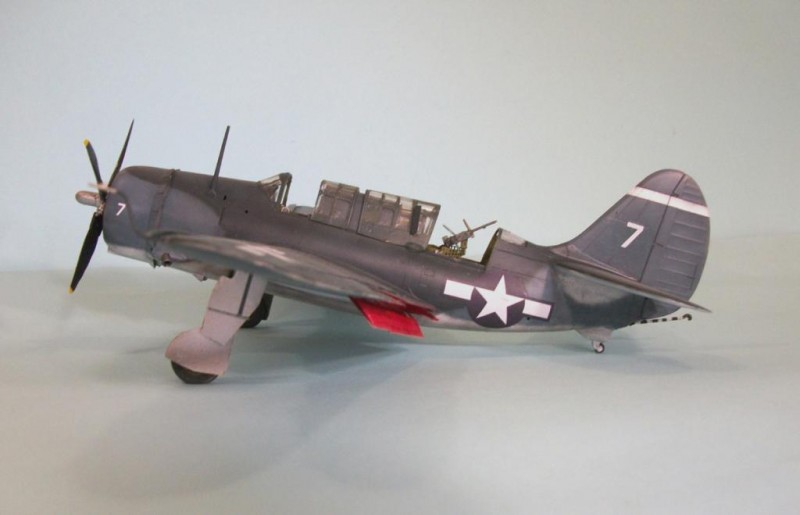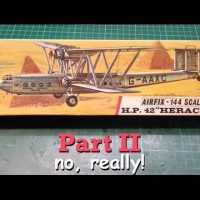1/48 Revell (Pro-Modeler) SB2C-3 Helldiver
Another "book project creates a model project" from TCWorld. I am currently writing what is becoming a book that looks like it will be "definitive" - "Fabled Fifteen: Air Group 15 in the Pacific War." Just this week I got handed material no other historical writer has had access to, given me by the son of Group Commander and Navy Ace of Aces Dave McCampbell (along with a lot of other similar material from other sources).
This is the Monogram/Pro-Modeler/Revell SB2C-4 Helldiver modified to a mid-production SB2C-3, using the Eduard SB2C-1 "Big Ed" set. The mid-production SB2C-3 lacks the clear glass area behind the pilot's canopy of the SB2C-1/1C and early -3, making it like the SB2C-4, with the other major visual clues being the non-perforated dive brakes of the earlier versions and the lack of a prop spinner (which meant I had to extend the prop hub on the kit prop). One mistake (since fixed): the area under the wing slats should be red. When you are bringing a wounded bird down the final approach to a deck that's bouncing 25 feet, you only want to glance a moment to see if the slats are properly deployed. Red lets you know.
The airplane is the one flown by Lt. John Bridgers, section leader of "The Silent Second" of VB-15, who flew it in his attack on "Musashi" and when he led the 1st wave of the TF-38 air strike against the last Japanese carriers at Cape Engano on October 25, 1944.
Bridgers is to me the quintessential naval aviator of the war. He graduated from Pensacola just before Pearl Harbor, qualified as a naval aviator making his three approaches and a landing aboard USS Enterprise returning from the Doolittle Raid, survived the sinking of the first Yorktown at Midway, flew from Saratoga at Eastern Solomons and from Cactus (Guadalcanal) before reporting aboard Bombing 15 in August 1943. The squadron went on to become the top-scoring dive bomber squadron in the top-scoring Navy Air Group of the war, and paid a heavy price: 38% casualties among the original "plank owners" flying through the Battle of the Philippine Sea, Halsey's Central Pacific Rampage, and the Battles of Leyte Gulf, losing 1/3 of their total losses for the deployment in the two weeks after that battle when they were called back halfway to Ulithi and home, to help stem the Japanese reinforcement of Leyte, suffering their greatest loss on November 11 at Ormoc Bay where the three most popular gunners and their pilots went in, which resulted in a "mutiny" by the surviving gunners on return to the Essex, which was only resolved (without hanging anyone from the yardarm) by real leadership on the part of McCampbell, following "the spirit of the law" rather than the letter.
I love Bridger's tale of how he became a Naval Aviator, since it gives a real feel for the reality "the Greatest Generation" dealt with:
A 1940 graduate of East Carolina Teacher's College, Bridgers had hoped to go on to medical school. However, he knew he had to go to work since his family was still dealing with the aftereffects of the Depression. As he recalled, “In North Carolina, a beginning teacher received a monthly salary of $96.50. From this salary one was expected to house, clothe and feed one's self as well as suffer pension withholdings and pay taxes. While contemplating that, I learned I could make $105.00 per month in the Navy as an Aviation Cadet with board, lodging and clothing furnished. In a year, if successful in flight training, I would be commissioned an Ensign in the Naval Reserve with a $250.00 per month salary, again with lodging provided and an allowance for food, and with a half-month's bonus for flight pay. Further, for foregoing four formative years one typically spent on temporary employment, the reserve aviator would receive $1000.00 per year bonus at discharge - $4,000. To a son of the Depression, these seemed princely arrangements, and the flight bonus would provide a nest egg if I needed more college before medical school.” Following graduation from Pensacola, he and his father listened to the New York Giants football game on the NBC Blue Network December 7 and heard it interrupted by news of Pearl Harbor; "I knew my plans had been forever altered."








Hi Tom, great example of "the beast" and a very interesting article to boot! Love the paint job & weathering on your Helldiver.
Tom... Great looking "Beast" and as usual, an interesting history to boot. I always learn a little bit of history of my model subjects, but I seem to forget, not only the history, who which kit I used as time goes by.
Great job! Your reviews of this kit on MM helped me alot. It's a great kit that deserves to be built more often.
I always enjoy hearing things like this - good to know there is something worthwhile happening from those reviews.